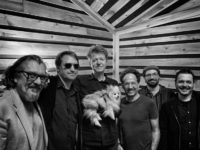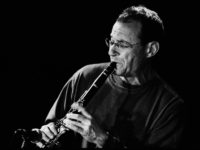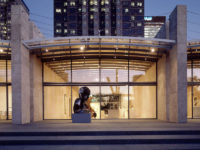by S. Victor Aaron
Recently, Wilco lead guitarist Nels Cline reconvened his scary good Nels Cline Singers and last spring the group released Initiate, an ambitious, 2-CD affair. So what does Cline do next? Why, he follows up today with another 2 CD release that’s pushing the boundaries even further than Initiate. Say hello to Dirty Baby.
Dirty Baby is not just a musical presentation; it came to life when writer and producer David Breskin commissioned Cline to make a “visionary recontextualization” of some paintings by L.A. artist Ed Ruscha. These paintings—sixty-six in all— are his so-called censor strip paintings from the 80s and 90s, abtract art created from bars that appear to block out words. It’s appropriate that Breskin would seek out Cline to interpret into music abstract art, since Cline is a master at abstract art (of the musical kind) himself. There’s some precedence to this: Breskin approached Bill Frisell to musically interpret Gerhard Richter’s paintings, and the resulting Richter 858 (2002) is one of my all-time favorite Frisells.
Now, I’m no visual art connoisseur, but I would suppose that it would require some creative, out-of-the-box thinking to come up with paintings based on censor strips. To put this into music would have to require even more unconventional thought. Cline assembles orchestral and modern group players he felt most comfortable with, and employs instruments as primitive as a cigarbox guitar and as technologically cutting edge as a “Quintronics Drum Buddy.” The compositions, which totally blurred the lines between composed and improvisation, were recorded digitally, but then mixed to 1 inch analog tape.
Here are some somewhat brief impressions of each disc, since each documents a different approach to interpreting the art:
Disc 1
The idea behind the music presented on this disc was to interpret 33 of Ruscha’s Silhoette paintings, and to do so in one long piece. Cline actually created six discreet but interconnected pieces, and not necessarily in the order of the paintings as Breskin envisioned, but it was evidently sufficient enough to make the point.
Cline brings in his Singers comrades Devin Hoff (contrabass, bass guitar) and Scott Amendola (drums, percussion) to perform on what the CD sleeve calls “Side A,” but this hardly makes it a NCS record, with the addition of noted producer/multi-instrumentalist/composer Jon Brion on keyboards, Wayne Peet on organ, Bill Barrett on harmonica, Glenn Taylor on pedal steel guitar, Jeremy Drake on various stringed instruments and Danny Frankel on percussion.
Beginning with a simple, two chord acoustic guitar strum (with each chord occupying its own channel), the six part first disc starts simple and innocent with acoustic, Americana flourishes, gradually building up in dissonance and aggressiveness until it reaches a downright menacing trip-hop groove on “Part VI.” Cline seems to be building up listeners’ tolerance of his unhinged side, a tact Naked City used for Radio (1993).
The highlight track of this bunch is Part “V,” incited by a funky mid-tempo pulse by Hoff and Amendola, fronted by Brion’s EMS Synthi noodling, and with all the various players comping and soloing at once in this sweaty stew, it’s just a trumpet away from being mistaken for a stray track from Miles’ Get Up With It.
Disc 2
The second thirty-three Ruscha paintings are part of his Cityscapes series, and here, Cline was asked to provide a very short piece to correspond with each painting. Again, Cline ends up going astray from the original intent, but the end result gets the job done, anyway.
The so-called “Side B” of the album is one of the wildest, most diverse, and uninhibited sides of Cline’s career, and that’s saying something. Hoff and Amendola are carried over, but joining them are Vinny Golia (flutes, woodwinds), Dan Clucas (trumpet, flutes), Jeff Gauthier (violin), Jessica Catron (cello), Jeremy Drake (electric and acoustic guitars), Brad Dutz (vibraphone, xylophones, frame drums, bongos), and twin brother Alex Cline (percussion). As this lineup suggests, there’s orchestration involved, but not always.
In adapting art to experimental music, Cline goes down a similar path as John Zorn’s brilliant collage Spillane, but while Zorn’s vision was wildly expansive and left absolutely nothing off-limits, Cline sets a few musical parameters for his project: the music seeks to relate to the violent or threatening nature of the paintings’ titles. The parameters are set wide, though, and the music lurches from the orchestral “In God We Trust” to the rapid bass-walking “If I was You I’d Do Just Like I Tell You To Do” to the avant-noise of “Do As Told Or Suffer.” Besides Zorn, Cline draws from the Chicago’s AACM crowd, Morton Feldman, Ellington, Gil Evans, blues and grindcore. With 33 pieces running from 34 seconds to a couple running over three minutes, these vignettes are collectively a pastiche of single ideas, instead of fully realized compositions. Even more than Side A, Side B is meant to be absorbed as a whole.
———————–
The two-disc box comes with reproductions of Ruscha’s works that inspired Cline’s pieces, as well as extensive liner notes (“A Word From Nels”), and studio photos. You’re getting a lot of paper with those two shiny, silver discs, but the paper offers much to contemplate, especially if you are a fan of—or just curious about—Ruscha’s artwork. For those who could not care less, Nels Cline’s imagination has nonetheless given them plenty of wild, unprocessed but filling earfood to chew on.
Like to see an alternative take on Dirty Baby? Check out Mark Saleski’s review from last week.
- Nick Millevoi – ‘Moon Pulses’ (2024) - April 23, 2024
- Cannonball Adderley – ‘Poppin’ in Paris: Live at L’Olympia 1972′ (2024) - April 20, 2024
- Christian Marien Quartett – ‘How Long Is Now’ (2024) - April 18, 2024




